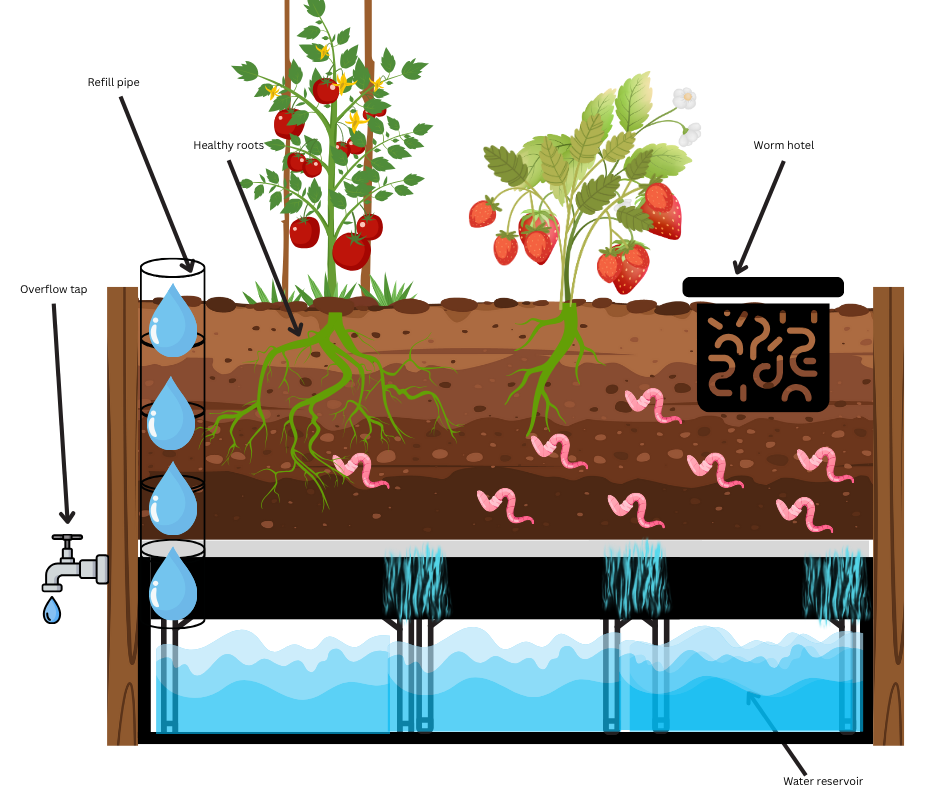Understanding the Concept and Benefits of Wicking Beds for Vegetable Gardening in Sydney
- Andrew Milne
- Jul 28
- 4 min read
Wicking beds are becoming increasingly popular among gardeners in Sydney. They offer an innovative approach to water management, which is crucial given the city’s climate. These garden beds provide a practical solution for growing vegetables while ensuring that plants receive a consistent supply of moisture. As urban gardening gains traction, learning about wicking beds can help maximize vegetable production even in limited spaces.
What is a Wicking Bed?
A wicking bed is a self-watering garden bed that uses capillary action to draw water up from a reservoir located beneath the soil. This gardening style is especially useful in areas like Sydney, where hot, dry weather can make it challenging to keep soil moist.
Essentially, a wicking bed is constructed with a waterproof lining that retains water in a lower layer. Above this layer, the soil is a mix designed for optimal drainage and aeration. As plants absorb moisture from the soil, the reservoir automatically replenishes it through capillary action, reducing the need for frequent watering. For example, a wicking bed can use up to 50% less water compared to traditional gardening methods.
How Does a Wicking Bed Work?
The operation of a wicking bed is based on its unique design and water dynamics. When water is added to the reservoir below, it gradually rises and saturates the soil above. As the roots of the plants reach down to access this moisture, they create an environment that fosters healthy growth.
Watering is far less frequent because plants can access moisture as needed. This is particularly crucial for vegetables like zucchini or cucumbers, which thrive on consistent watering for optimal yield. Research shows that consistent moisture levels can improve the growth rate of vegetables by up to 30%.

Benefits of Wicking Beds in Vegetable Gardening
1. Water Efficiency
Wicking beds excel in water efficiency due to their self-watering mechanism. This design reduces evaporation rates significantly, allowing gardeners to conserve water while still providing adequate hydration to their plants. For instance, using a wicking bed can save a gardener approximately 30 gallons of water per week compared to a traditional garden.
2. Reduced Maintenance
These garden beds require minimal maintenance once established. Busy gardeners can enjoy the fruits of their labor with less day-to-day oversight. Because they retain moisture efficiently, there is less need for daily monitoring, allowing more time for planning and harvesting.
3. Ideal for Urban Settings
With limited space in urban areas like Sydney, wicking beds can be adapted to fit patios, balconies, or even rooftop gardens. This versatility promotes sustainability and self-sufficiency, enabling city dwellers to cultivate their own food right at home. A study found that urban gardeners using wicking beds increased their vegetable yield by more than 40% compared to soil-based gardens.
4. Healthier Plants
Wicking beds help maintain consistent moisture levels, reducing the risk of water stress in plants. Healthier plants are likely to produce higher yields. For example, tomatoes grown in wicking systems can yield up to 25% more fruit than those in traditional beds. The robust root systems formed in wicking beds also enable plants to better access nutrients.
5. Easy to Build
Constructing a wicking bed is straightforward and can typically be completed with materials like old wooden pallets, bricks, or recycled containers. Clear DIY instructions are widely available, making it an accessible project for both novice and experienced gardeners.
Ideal Crops for Wicking Beds
While not every vegetable flourishes in a wicking bed, many popular crops do exceptionally well. Following vegetables tend to thrive in this system:
Tomatoes: Thrive with consistent moisture and can produce larger, juicier fruit.
Lettuce: Enjoys cool, moist conditions, leading to faster growth.
Carrots: Benefit from steady moisture for optimal root development.
Herbs (like basil and parsley): Prefer consistent watering and nutrient availability.
When planning your garden, consider each crop's unique needs. Using companion planting strategies can also enhance growth and maximize your space.
Setting Up Your Wicking Bed
Step 1: Choose the Location
Look for a sunny spot for your wicking bed, ideally one that receives 6-8 hours of sunlight daily. Make sure the location is accessible for maintenance and harvesting needs.
Step 2: Give Wickwell Gardens a Call
Wickwell Gardens:
Delivers and installs premium wicking beds.
Made with 100% food-grade materials.
Is Australian made.
Takes out all the guess work
Step 3: Plant Your Vegetables
After installing the bed, plant your vegetables, considering proper spacing to ensure plants have room to grow and access sunlight.
Maintenance Tips for Wicking Beds
While wicking beds demand less intervention, some maintenance remains critical. Regularly check the water level in the reservoir and replenish it as needed. Monitor your plants' health to see if they require additional nutrients or pest management.
During the warm summer months, you might consider adding a layer of mulch on the soil surface to minimize evaporation and maintain consistent soil temperatures.
Final Thoughts
Wicking beds provide an effective solution for vegetable gardening in Sydney, offering a sustainable and efficient gardening option. Their water-saving features and minimal maintenance make them perfect for urban gardening, where space is often limited.
By harnessing the advantages of wicking beds, you can enhance your gardening experience and grow healthier vegetables right at home. Whether you're an experienced gardener or just starting, embracing this innovative approach can lead to a flourishing garden in Sydney's vibrant urban environment.
_edited.jpg)





Comments